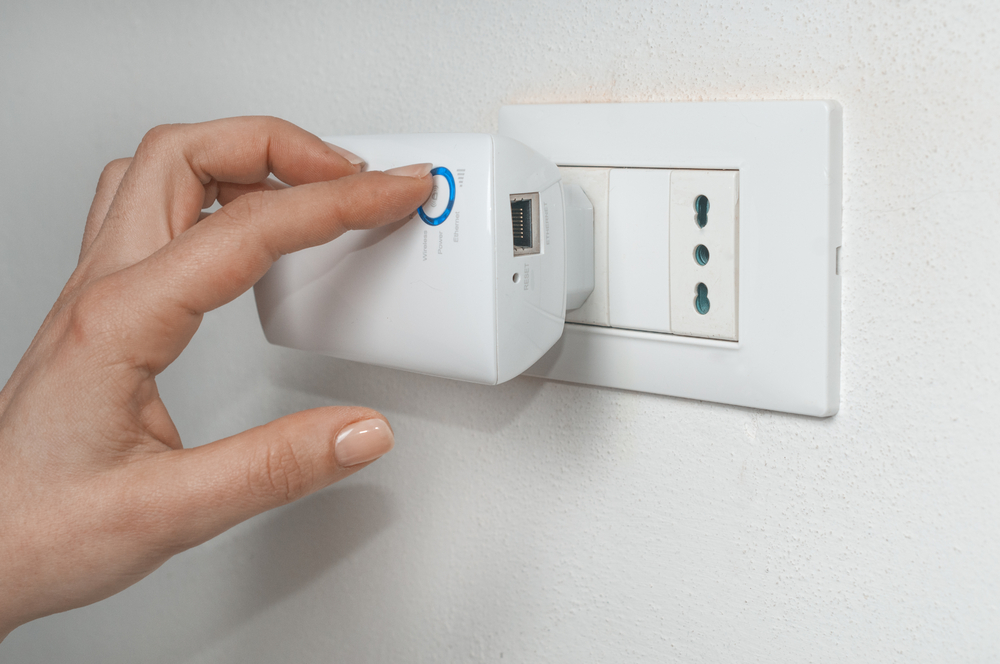
People living in large buildings often struggle with getting strong Wi-Fi signals in all parts of their homes.
They can use different signal boosting options to extend their Wi-Fi reach and connect to the internet in any spot.
A Wi-Fi range extender is one of these options that’s easy to use and effective.
However, you may wonder if it reduces your internet speed because of how it works.
Do Wi-Fi Extenders Slow Down Internet?

A range extender doesn’t slow down your original network’s speed because it can’t affect it.
These devices take the already established signal sent out by the router and boost it to reach the dead zones.
They can’t affect the bandwidth.
However, they send the internet to the connected devices at a lower speed.
They take the bandwidth from the router and split it in half because they can’t send and receive signals at the same time.
In other words, they can’t interact with the router and the connected devices simultaneously.
As a result, they can reach up to half of the original bandwidth under the best circumstances.
In addition, the packets sent from the router to the extender’s client have to travel two hops rather than one hop, as is the case with other devices directly connected to the router.
It will also lead to packet loss and lowered transfer speed.
Therefore, you shouldn’t see a range extender as a solution to improve speed.
Instead, it improves coverage but may lower the connected devices’ speed.
How Does A Range Extender Work?

If you use a Wi-Fi connection in your home, you must have noticed some dead spots around the house that your Wi-Fi signals can’t reach.
That’s because Wi-Fi signals can get blocked by different objects, preventing them from reaching some hard-to-reach spots.
Wi-Fi signals are radio-frequency waves that work at two different frequencies.
They create an imaginary net over your home that can give you internet connections when you’re inside the net.
However, this net doesn’t work flawlessly, and your Wi-Fi isn’t equally strong in all spots.
If there are several walls between the source of the Wi-Fi signal (the router) and your device, there’s a high chance of getting a weak signal.
The larger the place, the more dead spots you’ll have.
People who live in big or multi-story houses or even those who access the internet in their yards can experience weakened signals.
A Wi-Fi extender takes the Wi-Fi signal from the place they sit and amplifies them.
You can imagine this as a speaker amplifier that takes the sound signals from the source, boosts them, and sends them to the speakers.
When you put the range extender between the router and the dead spot, it takes the signals and extends them to reach those spots.
As you can see, a range extender can’t logically affect the internet speed.
You may feel the internet speed is higher because of the boosted signals, not due to increased speed.
Similarly, you may think that the range extender slows down the internet by taking signals from other parts of the house.
However, that’s not logical because the range extender takes the signals naturally reaching that spot and amplifies them by increasing their wavelength or repeating them.
That’s not how internet speed goes up and down.
Other factors affect internet speed, which we’ll cover below.
What Slows Down The Internet?

As mentioned, a Wi-Fi range extender doesn’t slow down your internet speed because it doesn’t occupy more bandwidth.
The most important factor determining your internet speed is the plan you purchased from your ISP.
If the plan isn’t high-speed, you can’t achieve faster internet speeds no matter what you do.
Here are the main factors that determine the speed of your internet.
1. Data Transfer and Connection Technology
The type of connection and technology used to transfer data to and from your device affects your internet speed.
Data transfer technology has come a long way from copper wires in telephone lines to fiber optic.
If you have a fiber-optic connection, you’ll have the fastest type, but dialup and ADSL are slower.
If you have an ADSL connection, your data is transferred from your home to the network centralizer via copper wires in the telephone lines.
Copper wires can’t maintain the same speed as data travels through them, and distance worsens this issue.
Therefore, the farther you are from your local telephone exchange, the more your internet speed drops.
Finally, it goes without saying that 2G, 3G, and 4G technologies differ considerably in terms of internet speed.
2. Other Connected Devices
The router can connect to multiple networks, and they automatically choose the fastest and least crowded network.
However, during peak hours, many devices connect to the same network, making it congested.
Each of these networks occupies a part of the bandwidth, slowing down your internet connection.
The connected devices within your home network also affect your internet speed.
If several devices are connected to your Wi-Fi simultaneously, you’ll experience a noticeable speed drop.
3. Software-Related Factors
Running multiple programs that need internet access can limit your bandwidth and slow down your internet speeds.
Even the type of applications you run affects your internet speed.
For example, if you stream videos, all your bandwidth is occupied with streaming videos, and you can use what’s left for data transfer.
Viruses and background processes can also take up your internet resources, slowing down your speed.
Even browser add-ons and plugins can also take up your bandwidth since they’re programs that run on the internet.
4. Hardware Issues
All the hardware components involved in data transmission can affect your internet speed.
From the wires and cables to the computer CPU, these hardware components can determine how fast your internet will be.
For example, if you have an old router, it can’t handle high speeds even if your data plan is high-speed.
An old and weak CPU can affect download speeds because it can’t handle the burden.
5. Wi-Fi Signals
The strength of Wi-Fi signals sent out from your router also significantly affects your internet speed.
The router’s location is a crucial factor that determines signal strength.
If you place your router away from your devices, on the ground, or blocked by dense materials like walls, metal, and concrete, you’ll experience lower speed.
Water is another known factor that can act as a barrier between your router and device, blocking signals.
If you have an aquarium, ensure it’s not sitting between the two devices.
Even your neighbors can affect your internet speed by occupying the channel you’re using.
That’s why routers allow you to change the channel via their web interfaces to boost speed.
Why Do You Get A Slower Speed With An Extender?

Although a Wi-Fi extender can speed up your internet by boosting Wi-Fi signals, you may experience lags even if you’ve placed an extender.
That’s not because the extender has lowered the speed, but other factors are at work.
1. Interference
The most important factor affecting an extender’s efficiency is other devices within the range emitting radiofrequency signals and interfering with the extender’s signals.
Microwave ovens are the biggest culprits here.
Other devices include cordless phones, Bluetooth devices, wireless security cameras, etc.
2. Distance
You won’t get your desired results if you put the extender in the wrong spot.
The further you put the extender from the router, the slower the speed will be.
If the extender can’t get a strong enough signal from the router, it can’t boost it.
Try placing the extender closer to the router and see if that helps increase the speed.
That said, you shouldn’t put the extender too close to the router, in which case there won’t be any point in having an extender.
3. Obstacles
Although extenders boost Wi-Fi signals, they can’t work efficiently if there are physical barriers between them and the router.
If so, they won’t have enough signal to start with.
4. Outdated firmware
You may be experiencing lags with your extender due to the bugs with the device.
If there are any bugs, the chances are high that the manufacturer has addressed them via their latest firmware updates.
Update your firmware and see if it helps.
Ensure you have a fast and reliable internet connection while updating the firmware.
If your internet connection stops in the middle of the update, it may render the device unusable.
5. Frequency Range
Routers work at two frequencies, 2.4 GHz and 5 GHz.
If your router and Wi-Fi extender have different frequencies, your extender will be useless.
Get a dual-band extender to switch to the router’s frequency range automatically.
What To Look For In A Wi-Fi Extender

If you decide that a Wi-Fi extender is your best choice for extending your Wi-Fi coverage, you need to consider some factors before purchasing one.
Here are the most important factors:
1. Type
There are different types of Wi-Fi extenders with different capabilities and features.
Depending on your preferences, you could choose between powerline adapters and router/extender combos.
A powerline adapter is a kit that includes two plugs; one goes into the router, and the other is connected to the client.
Powerline adapters connect to a power outlet, so they don’t have to talk to their clients on the same band they use to interact with the router.
As a result, they won’t experience lowered speed.
A router/extender combo consists of a unit that plugs into the modem and extends the Wi-Fi signal through a satellite.
You can have a seamless connection because both devices share the same SSID.
2. Size
The size of the Wi-Fi extender may be a determining factor if you have limited space.
If you have a small space, you may want to look for smaller ones that take up less space.
In such cases, a powerline adapter may be your best bet because they go into the wall outlet.
3. Extension Distance
The power of the extender is a crucial factor to consider because it determines its effectiveness.
Look at the transfer speed and distance expressed in feet.
The higher these numbers, the more effective the extender.
4. Connection
Some extenders work wirelessly, while others need an Ethernet connection.
A wireless device is more convenient but less reliable.
However, an Ethernet device can offer a more reliable connection even over long distances.
The catch is that you need to run cables through long distances, which can be inconvenient.
5. Compatibility
Although range extenders are convenient and easy to set up, they may express incompatibilities with the router.
If you can get an extender from the same brand as the router, you’ll experience fewer compatibility issues.
Since the router and the extender have different SSIDs and passwords, you may have difficulty setting them up.
You should also check if the extender gets frequent firmware updates to eliminate bugs and other issues.
Don’t buy an extender that never comes with a patch because outdated firmware can make your device useless.
Pros And Cons Of Range Extenders

If you live in a large house with dead zones, you can benefit from a range extender to eliminate those dead spots.
However, any device has pros and cons that can affect your decision.
Most of today’s range extenders don’t need a specific technical skill to set up.
They feature a plug-and-play setup mechanism and automatically configure themselves according to the router configurations.
You can run them right out of the box without any software installation.
In addition, Wi-Fi range extenders are generally less expensive than other alternatives, such as access points.
They also don’t require much maintenance, and you don’t need to hire a professional to set them up.
You don’t need extra cables or devices to set up the extender as it’s preconfigured and works out of the box.
Despite the advantages of a range extender, it may have disadvantages that make it an unlikely option.
One of the most important disadvantages of these devices is what we mentioned before.
Although they don’t affect the original speed of your network, they can affect the internet speed of their clients.
You do need to decide what you want to achieve with these devices.
If you want to increase the internet coverage of your Wi-Fi and perform tasks like web browsing, a Wi-Fi extender is a good choice.
However, if you want to use the extender for video streaming, you may want to look for other solutions.
Range Extender Alternatives

After weighing down the pros and cons of a range extender, you may realize it’s not the best option.
However, you’re not out of luck because you can still use other options to increase your Wi-Fi coverage.
Before choosing your best option, you may want to try a more affordable alternative.
For example, connecting your devices via an Ethernet cable may be the best option.
Ethernet offers fast and lag-free internet because wired connections are more reliable than wireless.
In addition, unlike Wi-Fi, Ethernet doesn’t need to divide its bandwidth among the connected devices.
Instead, each device can have its own bandwidth, leading to fast connections.
If an Ethernet connection isn’t convenient, you may want to try moving your devices closer to the router.
However, if you live in a multi-story house and don’t want to mess with the Wi-Fi setup, you can try the following options:
1. Access Points
An access point is an effective range-boosting device that connects to your router via an Ethernet cable and creates a WLAN (wireless local area network).
It works by transforming wired connectivity into a wireless connection.
By placing the access point near the dead zone, you can offer a reliable wireless connection to the nearby devices.
2. Mesh Networks
A mesh network includes several devices you can place near different dead zones and bring an internet connection to the places near them.
These devices are like nodes that create a network and extend the Wi-Fi signals to all rooms.
With a mesh network, your entire building is under an imaginary mesh, and if one of these nodes fails, other ones take over to ensure all devices remain connected.
3. Old Router As An Extender
If you have an old router, there’s no need to buy a new range-extending device.
You can connect it to your current router through an Ethernet cable and enter its web interface.
Remember to update its firmware before setting it up to ensure everything works smoothly.
After entering the router settings, look for the AP Mode and select it.
Save changes and exit the web interface.
This way, you can turn it into an access point that extends your Wi-Fi range.
NEXT: Is Hulu Free? (Everything To Know)

























